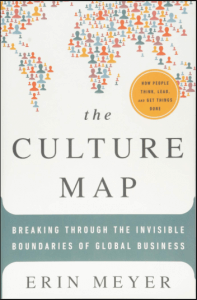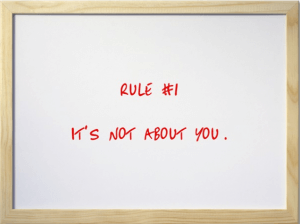How does Culture affect communication? Last fall I was privileged to travel for clients to far-away lands: South Africa, Egypt, and the Philippines, with a travel layover in Paris thrown in as a bonus. As an infrequent international traveler (although that seems to be changing), I had much to learn about airports, shots, Visas, jetlag, and… culture.
For years my go-to book for cultural advice has been Kiss, Bow, or Shake Hands. It gives history, social etiquette advice, business advice, and travel advice for 60+ countries. But I found it to be inaccurate for several of my destinations last year. For instance, the book told me that in Egypt, the left hand is unclean and should not be used for gestures. I found almost everyone using their left hand, and when I asked my host, he seemed shocked that it was even a “thing”.
Soon after my return, my brother (who has traveled internationally quite a bit with over a year-and-a-half total spent out of country) gave me a copy of The Culture Map.
The author – who has traveled and lived internationally most of her life – compares eight characteristics across cultures. She examines communication style, feedback, persuasion, leadership, decisions, trust, disagreeing, and timeliness. She then puts every major country on a scale, highlighting the differences with poignant and sometimes funny anecdotes of how lack of cultural awareness can lead to results that are awkward on one extreme and devastating to business at the other.
How does culture affect communication? We’ve long examined Culture in our workshops as it relates to skills. For example, palatable eye contact is notably different in the South (2-3 seconds) than the North (almost none) versus Asia (none due to honor and deference) to the extreme (10 seconds) in the Middle East. Gestures that are acceptable (or not) across the world are always an interesting conversation (no, you’re not #1, and it’s not OK, and we’re not at peace). We make the point that Culture trumps whatever “rule” we can establish. I remember a French student in one of our workshops telling an American he was too loud. “If you talk like that in France, we would dismiss you as being impolite.”
I had a blunt introduction to inter-cultural communication on my first foray as an international speaker. I had been invited to give the keynote to a mostly-European audience in Germany. When I was done, I was surprised that no one came up to speak to me. Usually as a speaker someone (or many someones) from the audience will come up to ask a question, offer a related story, or perhaps just share appreciation for a job well done. This group just cleared out. The room was empty just minutes after I was done. When I wandered the halls after the talk, no one really even spoke to me. I felt terrible. I had tried to research and create content that was palatable for an international audience. It was clear to me I had failed. I went to my German host and apologized for missing the mark and asked directly if there was feedback that I could improve upon. “Oh, they loved you!” I explained that no one had said a word to me. She laughed. “That’s just Germans. If you had done a bad job, I’d have found out immediately. They’re already wondering when you’ll come back.”
I’ve always given a loose definition of Culture as “an unwritten set of rules accepted by a group of people as law”. Culture could be defined by country, language, gender, age, professional group, family, job title, and even the type of car you drive. It’s an amazing field of study with enough nuance to keep any communicator on his toes.
Awareness of Culture can mean the difference between a friend and an enemy, becoming a preferred vendor or being blacklisted, a marriage in the royal court or a pending war. Understanding nuances is vital. For instance, a nod and a “yes” in Asia does not mean they agree. Many Asian cultures will simply not deny a direct proposal regardless of their intent.
An interesting chapter in Ms. Meyer’s book is on feedback. If I give you an annual review that goes like this: “We love having you on board. You’re a great asset to our team. But we start our day at 9 a.m. and I note you’re rarely at your desk at that time. It’d probably be a good idea if you could arrive prior to nine. But we look forward to your talents on our team and what you can do for us in the coming year.” Ask most any American what the message means and you’ll get a quick response: “You better get your tail to work on time!” But in some cultures of the world where indirect feedback is valued, your employee might resign to save you the embarrassment of having to fire them (not your intent). Direct feedback cultures might not even hear the correction, focusing on the front-and-center message that you love their work.
I had a “Duh!” moment from my time with an international client (before I read the book). I was trying to get the lead presenter to make The Ask. In true Western fashion, I wanted the core message front and center, repeated as often as possible and ending with a direct ask for the work (accompanied by eye contact and a genuine smile). What I got in practice was hints and hedges and hesitation. There was no direct ask. After reading the book, I realize I was asking this person to deny his upbringing and contradict every bit of courtesy he had ever been taught. An indirect culture does not ask for what they want, at least not bluntly. They hint and use nuance to get the query on the table. It’s weak to Western eyes and ears; it’s law in much of the Eastern world.
How does culture affect communication? One thing that doesn’t change and that I’m more and more adamant about is Rule #1. No matter who you are dealing with, successful communication requires a willful commitment to the receiver’s well-being. It’s not about you. The Culture of the audience is a major consideration worth examining. Although my next international trip is not scheduled for a while, I’ll be experiencing the grand cultures in the States with upcoming trips to Boston, Baltimore, Richmond, Kansas City, Lincoln, and Chicago. I’d love to hear about your experiences with different cultures.
Communication matters. What are you saying?
- How have you misread the Culture of your audience?
- What intercultural situations might give you cause for increased care when crafting your message?
- What assumptions are you making as you craft your main message?
Learn more about our public and on-site communications and speaking workshops and training.
This article was published in the April Edition of our monthly speaking tips email newsletter, Communication Matters. Have speaking tips like these delivered straight to your inbox every month. Sign up today to receive our newsletter and receive our FREE eBook, “Twelve Tips that will Save You from Making a Bad Presentation.” You can unsubscribe at any time.




